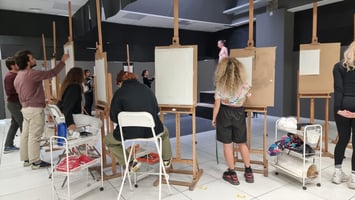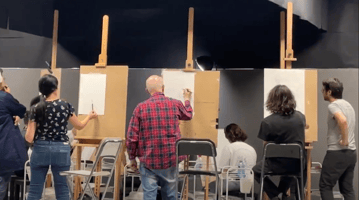Title: Real-time Feedback: Accelerating Your Progress in Art Introduction: Hey there, art...
The Power of Corrective Feedback in Art
Title: The Power of Corrective Feedback in Art Learning: Unleash Your Inner Picasso!
Introduction:
Welcome back, art enthusiasts! Today, we're diving deep into the world of corrective feedback in art learning. Have you ever wondered how artists improve their skills and create those jaw-dropping masterpieces? The secret lies in the feedback they receive and how they use it to refine their craft. In this blog post, we'll explore the importance of corrective feedback in art and how it can help you unlock your artistic potential. So, grab your brushes and let's get started!
Understanding Corrective Feedback:
Before we delve into the nitty-gritty, let's define corrective feedback. Simply put, it's constructive criticism aimed at identifying areas of improvement and guiding you towards growth. In the art world, feedback from instructors, peers, or even self-reflection can be a game-changer. It helps you identify your strengths and weaknesses, refine your technique, and take your art to new heights.
Fine-Tuning Your Skills:
Picture this: you're in an art class, diligently working on your latest masterpiece. Suddenly, your instructor appears by your side, offering insights and suggestions. This is where corrective feedback shines. It provides you with fresh perspectives and alternative techniques that can elevate your work. Whether it's adjusting proportions, tweaking color schemes, or refining brushwork, feedback helps fine-tune your skills and take your artwork to the next level.
Enhancing Self-Awareness:
Art is a deeply personal form of expression, making self-awareness crucial to growth. Corrective feedback acts as a mirror, enabling you to see your art from a different angle. It helps you identify patterns, recognize areas that need improvement, and challenge yourself. By embracing feedback, you'll develop a critical eye and become more attuned to your artistic style, pushing you further on your creative journey.
Building a Supportive Art Community:
Artists, like any other creative individuals, thrive in supportive communities. Feedback from your peers can be incredibly insightful, as they understand the struggles and triumphs you go through. Participating in art groups, workshops, or sharing your work online can open the doors to constructive feedback, enabling you to learn from others and cultivate meaningful connections. Remember, the journey to artistic excellence doesn't have to be a lonely one!
The Art of Giving and Receiving Feedback:
Now that we've emphasized the importance of corrective feedback, it's essential to master the art of giving and receiving feedback. When sharing your thoughts, be respectful, specific, and focus on the work itself rather than the artist. On the receiving end, keep an open mind and embrace feedback as an opportunity for growth. Remember, not all feedback will align with your vision, and that's okay! Filter and adapt the suggestions that resonate with you, ensuring your artistic voice remains intact.
Conclusion:
Artistic growth is an ongoing process, and corrective feedback is a vital tool in your arsenal. By embracing feedback, you can fine-tune your skills, enhance self-awareness, and build a supportive art community. So, next time you receive feedback, don't take it as a critique, but rather as a stepping stone towards unleashing your inner Picasso. Happy creating!
Introduction:
Welcome back, art enthusiasts! Today, we're diving deep into the world of corrective feedback in art learning. Have you ever wondered how artists improve their skills and create those jaw-dropping masterpieces? The secret lies in the feedback they receive and how they use it to refine their craft. In this blog post, we'll explore the importance of corrective feedback in art and how it can help you unlock your artistic potential. So, grab your brushes and let's get started!
Understanding Corrective Feedback:
Before we delve into the nitty-gritty, let's define corrective feedback. Simply put, it's constructive criticism aimed at identifying areas of improvement and guiding you towards growth. In the art world, feedback from instructors, peers, or even self-reflection can be a game-changer. It helps you identify your strengths and weaknesses, refine your technique, and take your art to new heights.
Fine-Tuning Your Skills:
Picture this: you're in an art class, diligently working on your latest masterpiece. Suddenly, your instructor appears by your side, offering insights and suggestions. This is where corrective feedback shines. It provides you with fresh perspectives and alternative techniques that can elevate your work. Whether it's adjusting proportions, tweaking color schemes, or refining brushwork, feedback helps fine-tune your skills and take your artwork to the next level.
Enhancing Self-Awareness:
Art is a deeply personal form of expression, making self-awareness crucial to growth. Corrective feedback acts as a mirror, enabling you to see your art from a different angle. It helps you identify patterns, recognize areas that need improvement, and challenge yourself. By embracing feedback, you'll develop a critical eye and become more attuned to your artistic style, pushing you further on your creative journey.
Building a Supportive Art Community:
Artists, like any other creative individuals, thrive in supportive communities. Feedback from your peers can be incredibly insightful, as they understand the struggles and triumphs you go through. Participating in art groups, workshops, or sharing your work online can open the doors to constructive feedback, enabling you to learn from others and cultivate meaningful connections. Remember, the journey to artistic excellence doesn't have to be a lonely one!
The Art of Giving and Receiving Feedback:
Now that we've emphasized the importance of corrective feedback, it's essential to master the art of giving and receiving feedback. When sharing your thoughts, be respectful, specific, and focus on the work itself rather than the artist. On the receiving end, keep an open mind and embrace feedback as an opportunity for growth. Remember, not all feedback will align with your vision, and that's okay! Filter and adapt the suggestions that resonate with you, ensuring your artistic voice remains intact.
Conclusion:
Artistic growth is an ongoing process, and corrective feedback is a vital tool in your arsenal. By embracing feedback, you can fine-tune your skills, enhance self-awareness, and build a supportive art community. So, next time you receive feedback, don't take it as a critique, but rather as a stepping stone towards unleashing your inner Picasso. Happy creating!



